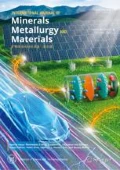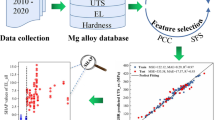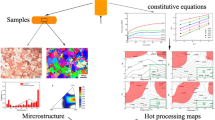Abstract
The machine-learning approach was investigated to predict the mechanical properties of Cu-Al alloys manufactured using the powder metallurgy technique to increase the rate of fabrication and characterization of new materials and provide physical insights into their properties. Six algorithms were used to construct the prediction models, with chemical composition and porosity of the compacts chosen as the descriptors. The results show that the sequential minimal optimization algorithm for support vector regression with a puk kernel (SMOreg/puk) model demonstrated the best prediction ability. Specifically, its predictions exhibited the highest correlation coefficient and lowest error among the predictions of the six models. The SMOreg/puk model was subsequently applied to predict the tensile strength and hardness of Cu-Al alloys and provide guidance for composition design to achieve the expected values. With the guidance of the SMOreg/puk model, Cu-12Al-6Ni alloy with a tensile strength (390 MPa) and hardness (HB 139) that reached the expected values was developed.
Similar content being viewed by others
References
J.L. Liu, H.Y. Huang, and J.X. Xie, Effects of aging treatment on the microstructure and superelasticity of columnar-grained Cu71Al18Mn11 shape memory alloy, Int. J. Miner. Metall. Mater., 23(2016), No. 10, p. 1157.
M. Izadinia and K. Dehghani, Microstructural evolution and mechanical properties of nanostructured Cu-Al-Ni shape memory alloys, Int. J. Miner. Metall. Mater., 19(2012), No. 4, p. 333.
A. Sata and B. Ravi, Comparison of some neural network and multivariate regression for predicting mechanical properties of investment casting, J. Mater. Eng. Perform., 23(2014), No. 8, p. 2953.
N. Altinkok and R. Koker, Neural network approach to prediction of bending strength and hardening behaviour of particulate reinforced (Al—Si—Mg)—aluminium matrix composites, Mater. Des., 25(2004), No. 7, p. 595.
B. Zhao, T.Y. Yu, W.F. Ding, X.Y. Li, and H.H. Su, BP neural network based flexural strength prediction of open-porous Cu—Sn—Ti composites, Prog. Nat. Sci., 28(2018), No. 3, p. 315.
J.L. Tang, C.Z. Cai, S.J. Huang, and T.T. Xiao, Strength prediction for Al—Cu—Mg—Ag alloy based on support vector regression, J. Aeronaut. Mater., 32(2012), No. 5, p. 92.
G.X. Liu, L.N. Jia, B. Kong, S.B. Feng, H.R. Zhang, and H. Zhang, Artificial neural network application to microstructure design of Nb—Si alloy to improve ultimate tensile strength, Mater. Sci. Eng. A, 707(2017), p. 452.
X.W. Yang, J.C. Zhu, Z.S. Nong, D. He, Z.H. Lai, Y. Liu, and F.W. Liu, Prediction of mechanical properties of A357 alloy using artificial neural network, Trans. Nonferrous Met. Soc. China, 23(2013), No. 3, p. 788.
S.A. Razavi, F. Ashrafizadeh, and S. Fooladi, Prediction of age hardening parameters for 17-4PH stainless steel by artificial neural network and genetic algorithm, Mater. Sci. Eng. A, 675(2016), p. 147.
D. Wu, W.L. Wang, L.G. Zhang, Z.Y. Wang, K.C. Zhou, and L.B. Liu, New high-strength Ti—Al—V—Mo alloy: from high-throughput composition design to mechanical properties, Int. J. Miner. Metall. Mater., 26(2019), No. 9, p. 1151.
Y.T. Lv, L.Q. Wang, J.W. Mao, and W.J. Lu, Recent advances of nickel—aluminum bronze (NAB), Rare Met. Mater. Eng., 45(2016), No. 3, p. 815.
Z.H. Deng, H.Q. Yin, X. Jiang, C. Zhang, K.Q. Zhang, T. Zhang, B. Xu, Q.J. Zheng, and X.H. Qu, Machine leaning aided study of sintered density in Cu-Al alloy, Comput. Mater. Sci., 155(2018), p. 48.
H. Wan, N.C. Si, G.L. Liu, M. Li, C. Xu, and L. Xu, Effect of rare earth on abrasion resistance of multi-aluminum bronze, Chin. Rare Earths, 36(2015), No. 4, p. 81.
Y.Y. Li, W. Xia, W. Zhang, and Z.Q. Luo, Strong and wear resistant aluminum bronze alloy and its tribological characteristics, Chin. J. Nonferrous Met., 6(1996), No. 3, p. 76.
B.B. Lahiri, A. Sarkar, S. Bagavathiappan, A. Nagesha, T. Saravanan, R. Sandhya, T. Jayakumar, and J. Philip, Studies on temperature evolution during fatigue cycling of Ni—Al bronze (NAB) alloy using infrared thermography, Insight: Non-Destr. Test. Cond. Monit., 58(2016), No. 2, p. 70.
B. Zhang, X.J. Xu, S.D. Chen, and W. Jiang, Effects of zirconium and strontium on microstructure and properties of nickel aluminium bronze ingot, Trans. Mater. Heat Treat., 36(2015), No. 3, p. 62.
J.M. Ji, Y.Y. Lu, J. Wu, and G.C. Meng, Microstructure and wear resistance of new aluminum bronze with Ce, Spec. Cast. Nonferrous Alloys, 33(2013), No. 7, p. 672.
Z.L. Guo, W.X. Tang, H.L. Zhang, J. Xu, and G. He, Influences of alloying elements on the properties of nickel aluminum bronzes, Dev. Appl. Mater., 18(2003), No. 2, p. 39.
B. Thossatheppitak, S. Suranuntchai, V. Uthaisangsuk, A. Manonukul, and P. Mungsuntisuk, Mechanical properties at high temperatures and microstructures of a nickel aluminum bronze alloy, Adv. Mater. Res., 683(2013), p. 82.
J. Anantapong, V. Uthaisangsuk, S. Suranuntchai, and A. Manonukul, Effect of hot working on microstructure evolution of as-cast nickel aluminum bronze alloy, Mater. Des., 60(2014), p. 233.
A.L. Dai, G.C. Yan, Z.Y. Zhu, and J.S. Liu, Effect of aluminum content on microstructure and properties of casting CuAlxFe3, Nonferrous Met. Eng., 3(2013), No. 4, p. 22.
J.H. Wang, X.X. Jiang, and S.Z. Li, Microstructure and properties of boron—aluminum bronze, Acta Metall. Sin., 32(1996), No. 10, p. 1039.
B.W. Wang, T. Wang, and Z.T. Wang, Copper Alloy and Its Processing Technology, Chemical Industry Press, Beijing, 2007, p. 45.
Y.W. Li, L.R. Xiao, W. Zhang, X.J. Zhao, Y.F. Song, and L. Guo, Microstructure and mechanical properties of aluminum bronze with different Mn contents, Chin. J. Rare Met., 41(2017), No. 9, p. 985.
A.L. Dai, G.C. Yan, Z.Y. Zhu, K. Zhu, H. Chen, and W.M. Niu, Wear-friction behavior of novel high aluminum bronzes alloy Cu—12Al—X in high temperature condition, Chin. J. Nonferrous Met., 23(2013), No. 11, p. 3083.
W.S. Li, Z.P. Wang, Y. Lu, Y.H. Jin, L.H. Yuan, and F. Wang, Mechanical and tribological properties of a novel aluminum bronze material for drawing dies, Wear, 261(2006), No. 2, p. 155.
Y.H. Jin, Y. Lu, Z.P. Wang, W S Li, and J.L. Xu, Anti-frictional characteristic of new complex Al—bronze Cu—14Al, Spec. Cast. Nonferrous Alloys, 24(2004), No. 3, p. 32.
J.L. Xu, Z.P. Wang, C. Chen, and P.Q. La, Research into a new high-strength aluminium bronze alloy, Int. J. Mater. Prod. Technol., 21(2004), No. 5, p. 443.
Z. Li and C.G. Li, The preparation of abrasion-resistive, antifrietional complex aluminum bronze, Shanghai Nonferrous Met., 14(1993), No. 6, p. 13.
F. Liu, Research on Microstructure and Processability of High Aluminium Bronze Alloy [Dissertation], Jiangxi University of Science and Technology, Ganzhou, 2014, p. 24.
M. Sadayappan, M. Sahoo, and H.T. Michels, Optimization of composition and mechanical properties of aluminum bronze alloy C95400, Trans. Am. Foundry Soc., 112(2004), p. 509.
A.Q. Wang, R. Xu, and C.Z. Chi, The friction characteristic and tensile properties of casting Al—bronze, J. Liaoning Tech. Univ. (Nat. Sci. Ed.), 19(2000), No. 1, p. 87.
A.L. Dai, G.C. Yan, Z.Y. Zhu, and J.S. Liu, Effects of heating treatment on friction and wear properties of novel high aluminum bronze alloy, Mater. Mech. Eng., 13(2013), No. 12, p. 333.
C.X. Wang, C.H. Jiang, Z. Chai, M. Chen, L.B. Wang, and V. Ji, Estimation of microstructure and corrosion properties of peened nickel aluminum bronze, Surf. Coat. Technol., 313(2017), p. 136.
D.L. Hu, J.C. Cao, Z. Zhou, and S.Q. Zhang, Organism and properties of high-strength and wear-resistant bronze, Non-ferrous Met., 50(1998), No. 3, p. 99.
Z.B. Qin, Q. Zhang, Q. Luo, Z. Wu, B. Shen, L. Liu, and W.B. Hu, Microstructure design to improve the corrosion and cavitation corrosion resistance of a nickel—aluminum bronze, Corros. Sci., 139(2018), p. 255.
M.E. Moussa, M.A. Waly, and M. Amin, Effect of high intensity ultrasonic treatment on microstructural modification and hardness of a nickel—aluminum bronze alloy, J. Alloys Compd., 741(2018), p. 804.
X.J. Xu, S.D. Chen, L. Pan, J. Wei, and G.F. Shi, Microstructure and properties of Zr microalloying nickel aluminum bronze ingot, Chin. J. Rare Met., 38(2014), No. 1, p. 158.
M. Yaşar and Y. Altunpak, The effect of aging heat treatment on the sliding wear behaviour of Cu-Al-Fe alloys, Mater. Des., 30(2009), No. 3, p. 878.
C.Z. Zhang, Q.X. Sun, and H.X. Zhang, Sintering mechanism of Cu-Al system powder billet, J. Northeast Univ. Technol, 10(1989), No. 5, p. 561.
R. Wang, Y.P. Bao, Y.H. Li, Z.J. Yan, D.Z. Li, and Y. Kang, Influence of metallurgical processing parameters on defects in cold-rolled steel sheet caused by inclusions, Int. J. Miner. Metall. Mater., 26(2019), No. 4, p. 440.
L. Panda, P.K. Banerjee, S.K. Biswal, R. Venugopal, and N.R. Mandre, Artificial neural network approach to assess selective flocculation on hematite and kaolinite, Int. J. Miner. Metall. Mater., 21(2014), No. 7, p. 637.
K. Xu, Y.H. Ai, and X.Y. Wu, Application of multi-scale feature extraction to surface defect classification of hot-rolled steels, Int. J. Miner. Metall. Mater., 20(2013), No. 1, p. 37.
K.Q. Zhang, H.Q. Yin, X. Jiang, X.Q. Liu, F. He, Z.H. Deng, D.F. Khan, Q.J. Zheng, and X.H. Qu, A novel approach to predict green density by high-velocity compaction based on the materials informatics method, Int. J. Miner. Metall. Mater., 26(2019), No. 2, p. 194.
F.F. Yang, H.J. Kang, E.Y. Guo, R.G. Li, Z.N. Chen, Y.H. Zeng, and T.M. Wang, The role of nickel in mechanical performance and corrosion behaviour of nickel—aluminium bronze in 3.5wt% NaCl solution, Corros. Sci., 139(2018), p. 333.
Q.F. Kang, S.B. Hu, S.Q. Zeng, and G.K. Chen, Heat treatment strengthening of nickel—aluminum bronze alloy for marine propeller, Chin. J. Nonferrous Met., 28(2018), No. 1, p. 107.
G.Q. Tian, Y. Lu, K. Lu, and W.S. Li, Influence of Co on the wear behavior of high-aluminum bronze, Rare Met. Mater. Eng., 27(2008), No. 10, p. 1833.
S.S. Rathore and V.V. Dabhade, Dimensional change during sintering of Fe—Cu—C alloys: a comparative study, Trans. Indian Inst. Met., 69(2016), No. 5, p. 991.
J. Miettinen, Thermodynamic description of the Cu-Al-Ni system at the Cu-Ni side, Calphad, 29(2005), No. 1, p. 40.
Y.L. Lin, J.G. Hsieh, H.K. Wu, and J.H. Jeng, Three-parameter sequential minimal optimization for support vector machines, Neurocomputing, 74(2011), No. 17, p. 3467.
B. Üstün, W.J. Melssen, and L.M.C. Buydens, Facilitating the application of support vector regression by using a universal pearson VII function based kernel, Chemom. Intell. Lab. Syst., 81(2006), No. 1, p. 29.
Acknowledgment
The authors acknowledge financial support from the National Key Research and Development Program of China (No. 2016YFB0700503), the National High Technology Research and Development Program of China (No. 2015AA03420), Beijing Science and Technology Plan (No. D16110300240000), National Natural Science Foundation of China (No. 51172018), and the Science and Technology Research Program of Chongqing Municipal Education Commission (No. KJQN201801202).
Author information
Authors and Affiliations
Corresponding author
Rights and permissions
About this article
Cite this article
Deng, Zh., Yin, Hq., Jiang, X. et al. Machine-learning-assisted prediction of the mechanical properties of Cu-Al alloy. Int J Miner Metall Mater 27, 362–373 (2020). https://doi.org/10.1007/s12613-019-1894-6
Received:
Revised:
Accepted:
Published:
Issue Date:
DOI: https://doi.org/10.1007/s12613-019-1894-6




